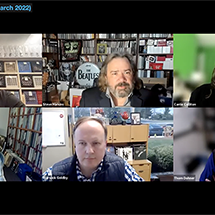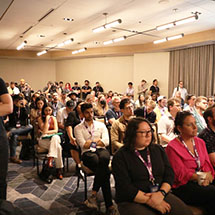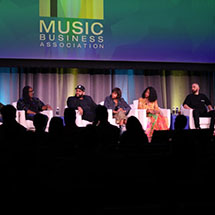
[Keeping Tempo With Music Biz] — Optimizing For The Music Business’ Digital Future: Interview with Reprtoir’s Dominique Rottet

Reprtoir’s story is that of technology born out of the needs of an ever-changing music industry. Founded nearly ten years ago as an asset management software solution for another company, the platform has become a SaaS solution for music industry professionals in all areas of the business. In our latest Keeping Tempo interview, we discuss the platform’s evolution and how it was designed to adapt to our industry’s frequent evolution with Reprtoir’s Co-Founder and CEO, Dominitue Rottet!
Music Biz: Can you give us a brief history behind Reprtoir and how the company got to where it is today?
Dominique Rottet: Reprtoir started out as a side-project of a licensing company, Rendez-Vous Digital. We needed an internal software to manage our assets, from audio files to royalties, but couldn’t find one that fit our needs on the market. So we developed it ourselves, and then realized there might be a need for Reprtoir at other companies. There wasn’t really any other workspace that could centralize that many tasks on the market yet. So we decided to build a commercializable version. This was back in 2015.
So Reprtoir became a SaaS solution, specifically designed for record labels and music publishers. Since then, our workspace has become able to help out any kind of music company really. Our goal is to be precise; we’re making a solution to a very specific problem that we know really well. We’re not pretending to be knowledgeable about everything, just about our actual experience of the music industry.
Reprtoir was made by music professionals for music professionals, with one goal in mind: helping music actors optimize and grow their businesses.
Music Biz: Reprtoir bills itself as “a powerful software designed for modern music businesses” — what were the specific needs for today’s music companies that you sought to address when building out your platform?
DR: The basis of Reprtoir is a strong and reliable Catalog Management system (CMS). Our CMS is specifically built for music catalogs and metadata attached to it, while being a secured workspace. Of course, it is a collaborative online space, so it can be opened to anyone from a team, with permissions to give. So from audio files to musical works, everything can be centralized in one workspace. That was stage 1.
Then, by popular demand, we developed Music Sharing features, through private playlists and real-time data analytics on what was listened to and how many times. Quickly, we also added the ability to send releases to The Orchard and Believe directly from the Reprtoir workspace. That was our second stage, outside compatibility.
After that, we tackled one of the most important parts of our business: royalties management. We added a royalty accounting engine that is able to import any digital statement directly into Reprtoir for analysis, capture the relevant information, and take out any mistakes to be corrected. This was step 3: the optimization of administrative tasks.
Now we’ve added cutting-edge technology to make it easily accessible by all music companies. Audio AI was released in 2023 with Cyanite to add auto-tagging and similarity search in our Catalog Management tool. This helped a lot of our users to get organized faster and identify the right pitches for potential new partners or prospects.
Finally, pulling the thread of pitching, we released several features to share assets through Reprtoir accounts. First we debuted our Assets Hub, a way to freely share tracks, works, or any other asset through Reprtoir’s platform while making sure that it remains safe for the catalog owner. We’re also releasing Libraries; now it’s not only about sending private links, it’s about allowing selected people into a private online space hosted by Reprtoir, to give users insights on a catalog and help to synch & license it. This is step 4: becoming a hub for music companies to rely on safety and reliability-wise.
The makeup of the Reprtoir platform is now fairly complete, and we are glad to see that we’re tackling more and more key aspects of the music industry’s digital transition. It’s all about supporting these changes and giving music businesses of all sizes the ability to keep up with an environment that rapidly changes and doesn’t facilitate manual management anymore.
Music Biz: Building an easy-to-understand user experience is paramount to launching a tech platform in a world that’s been trained to use apps for some time.
DR: Of course Reprtoir’s goal has always been to be the most complete all-in-one workspace for the music industry, and we’re still very focused on our goal. We’re only working with music companies and their business management, not their pitches, their training or anything irrelevant to business administrative tasks. We provide the tools we’ve always needed in our jobs in the music industry (especially music licensing).
This means that we’re always keen to connect with other platforms and apps. One key element about Reprtoir is that we make it a point of honor to be compatible with as many other platforms and formats as we can. This is a long-standing issue for our industry; compatibility has always been a pain point and we’ve experienced this for years. On another pain subject, we are now fully CWR compliant, and we allow music publishers to upload and download their works in that format.
We’re also able to integrate with nearly any other music service. For our royalty accounting system to ingest files from a platform, we need to integrate it into Reprtoir’s system. Every time a user requests one, we do our best to integrate them as well, to be sure that any aggregator, distributor, digital store, etc. is part of our ecosystem. We now have more than 220 integrated services, from digital distributors to Collective Music Organizations, and we keep adding more as the need arises.
We are not trying to be the only app or platform for the music industry; we have our expertise in music business management and we’re centralizing related activity in Reprtoir. As for the rest, we make sure that we can work together.
Music Biz: Earlier this year, the company launched its Assets Hub and Inbox features to facilitate easier music asset sharing. What considerations were important to factor in when developing a music-centric file-sharing offering?
DR: First and foremost: safety. It’s incredibly difficult to keep track of every permission and access to metadata on a non-specialized platform. And it seems candid to say, but we couldn’t believe there were platforms designed for the specific needs of every industry other than music. So we made it easy to go from a workspace where all assets are organized to a way to share some of them to a selection of profiles created on Reprtoir. That solution is only applicable when working in the music industry.
Then, making sure that the platform is reliable. This tends to the robustness of our platform of course but also in users’ ability to use the solution. A user-friendly platform means it’s easier to manage and by extension, to better protect and share assets there. And if you’re going to spend time looking at the platform you’re working on, share it to your team and to your partners, it needs to be easy to use and to look at.
And of course, it was about customizing the space. Sure it’s hosted by Reprtoir, but it’s still our clients’ catalogs. So we added a few features to allow them to make the platform their own by adding their logo, their color code, etc.
But soon, Libraries will be out! This will streamline the whole process: any user will be able to open up an online Library to display parts of their catalog, organized as they wish. These assets will be downloadable or not, open to only a few people whose access will be regulated by the users in their workspace. Again, we’re centralizing as much as possible to avoid unnecessary manipulations on their catalogs.
Music Biz: As more and more of our industry goes digital, music and tech companies enjoy a much more collaborative culture now than in decades past. Can you share your perspective on how both industries stand to benefit from working together to develop functional, music-specific toolsets?
DR: Collaboration between the two industries is getting better. We are the actual proof of it!
Historically yes, there have been a lot of issues collaboration-wise — and I deplore that it’s still the case today with a lot of big players in the industry. The music industry started a digital transition once its back was against the wall. I’ve always thought of innovation as a tool to help, not a threat. During the pandemic, everything went way faster since we could only rely on digital solutions. Interest towards solutions like Reprtoir vastly grew during that period.
It’s essential that music and tech work hand in hand. We can’t ignore the changing environment music companies are evolving in. Music consumption habits changed, the way we promote music changed, and sources of revenue have not only changed but also multiplied. Whether you’re happy or not with streaming, social media or any online platform licensing music, there’s no way around it: you have to track everything that’s going on around your music. If the field is changing, so do you; it’s all about staying ahead of the curve and making sure you can keep up with the pace.
Which means that managing a catalog can’t really be manual anymore. It can give you a very specific objective and/or small catalog, but all in all, managing a catalog monetization can’t be done without the right tools. Since the digital aspect of the music industry is moving the lines so much, it’s important to know how to manage this new flow of data, manage and value your catalog.
Music Biz: To that point, AI-based technologies are obviously on everyone’s minds right now. How can companies like Reprtoir’s leverage AI to enhance business practices in our industry, or how are they already doing so?
DR: When it comes to AI, the real advantage we can get out of it is automation. That is currently the easiest and the most efficient way to use AI at its full potential.
That’s what we started to do with Audio AI. We integrated cutting-edge technology into our workspace to improve our users’ workflow. With this feature, our users are able to auto-tag their catalog through an AI solution and use similarity search when looking for the right track to pitch. It helps on several levels; first it allows you to save time in tagging catalogs. But it also helps rethink the way we work.
Allowing these smart tools to help our processes is great; it opens up a brand new horizon. For example, one of our clients using Audio AI told us how similarity search helped them research tracks in their catalogs to fit a specific demand. Not only does AI take away the subjectivity and long hours of tagging by a human, it allows you to search for something using your content itself. Looking for something a bit like the track you have but more upbeat? You can use these tools to find it. It’s saving time, making it easier to choose from your catalog and sometimes even makes some suggestions you wouldn’t have thought of! You’re covering all your bases.
Another nice addition,in my opinion, is that we’ve added prompt searches to go even further. This means that users are able to look for the perfect track with a simple description, which will be automatically translated into the closest musical equivalent to start a search in your catalog. All these AI features are not only available in the workspace, but also in Libraries. Meaning that data management only has to be done once, it can be replicated in the onlines spaces you’d open for partners and clients.
It’s all about learning how to use it well. It won’t replace a music professional, their experience, relations, etc. But it will help music professionals work more efficiently. And that’s exactly what we should be thinking of when we talk about AI in the music industry: efficiency and automation.
Music Biz: Tech integrations make royalty income tracking easier than ever, especially given the ever-fragmented nature of micropayments across many different streaming and UGC platforms. How does Reprtoir support artists & rightsholders keep track of all the places their income is coming from?
DR: Reprtoir is solely B2B, meaning that we mainly work with record labels and music publishers. Our users have the ability to fill in all details of their contracts and royalty splits in their workspace in Reprtoir and then ingest their royalty statements to be crawled by our system. If errors are still in the files, Reprtoir takes them apart and asks for the users to verify or modify them. And that’s it! Data management at its best: optimized by tech with oversight by humans.
That’s an illustration of what we were saying before: tech is here to support and optimize the most tedious parts of our jobs. Our core activities aren’t reading through thousands of lines in an Excel file, it’s to make sure that operations are going smoothly, catalogs are valued and that, in the end, artists & rightsholders are getting what they’re owed. This part is managed by a workspace which has been designed especially for that reason.
Music Biz: In the last half-decade, our industry has seen a major focus on finding new ways to further monetize existing catalogs outside of streaming and sales. How do platforms like Reprtoir help rightsholders seize opportunities to boost their catalog income?
DR: Right now, the industry’s revenue mainly comes from streaming platforms, collective management societies, and sync. These are the main streams of revenue and yet, it’s pretty slim for a lot of the music companies out there. There is still a certain portion of the industry that continues to sell physical products, but let’s be honest, the majors largely dominate what remains of this market. There’s a clear need for movement here.
In terms of new leads to explore, we’ve seen the rise of NFTs, blockchain with shopping solutions. Ultimately all of these are still in the early stages, and we’ve seen how big tech trends have gone away as fast as they came. It’s a lot of time spent on understanding the possibilities and trying them out to in the end leave them by the wayside. We are still vigilant and will be where our clients’ needs are. I believe that solutions for monetizing superfans are a natural, logical evolution that could pay off for the industry in the coming years, but there is still a lot to be done. I’m still debating on that, to be honest!
Music Biz: You recently published a blog on the importance of bolstering environmental sustainability in the music industry as more and more tech is integrated into its daily operations. As an all-digital platform in the music space, how does Reprtoir view its role in creating a more sustainable music industry?
DR: At our level, mutualizing cloud needs for multiple companies on a single platform is an initial step towards enhancing sustainability. Plain and simple: we avoid multiple storage solutions, multiplying softwares, etc. This is the first easy step that we took ourselves when we developed Reprtoir.
Secondly, our work methods and technology choices enable us to be actively involved. For instance, opting to develop maximum functionalities by leveraging serverless technology not only offers great power, but also consumes minimal energy.
Efforts must be made by all, each at their own level. We’re still a digital solution, so we know we have some kind of impact, even though it’s tough to have a clear and precise idea of what it is in terms of volume. But we are still very vigilant about this when given the choice.
Music Biz: Looking forward, what do you see as the most pressing opportunities and challenges the music industry will face in the next year, five years, and so on?
DR: We are facing so many challenges it’s tough to know where to start! In my opinion, music companies’ actual digital transition is the very first step we need to take. This is what will likely facilitate the change throughout the whole industry.
For instance, the digital transition of a record label isn’t merely about delivering its music to a distributor who then supplies it to DSPs. I see this as a misconception; most of these companies will lose their data within three years if they’re not looking after it and keeping some control over it. This is based on concrete cases we regularly encounter, there’s still a lot of sensibilization to do, which is very normal, it’s a transition phase after all.
To me, the genuine digital transition goes much further. It involves empowering rightsholers over their content, shifting from passivity to an active involvement, being free to progress, and seizing business opportunities. It’s all about understanding the global changes happening outside of music business management. Platforms are multiplying, content can be used in ways we never really thought of before. And it changes a lot of aspects in music business management.
Digital transition means managing your content, and by extension your own organization, by yourself. It’s here to help maintain independence to make business-related decisions, supported by modern and powerful specialized tools to enhance productivity and stay competitive. Reprtoir is a commercial platform that embodies this ambition.
You can read past “Keeping Tempo” articles via the portal linked here. And, stay tuned for more insightful discussions from our members and partners from across the industry!












